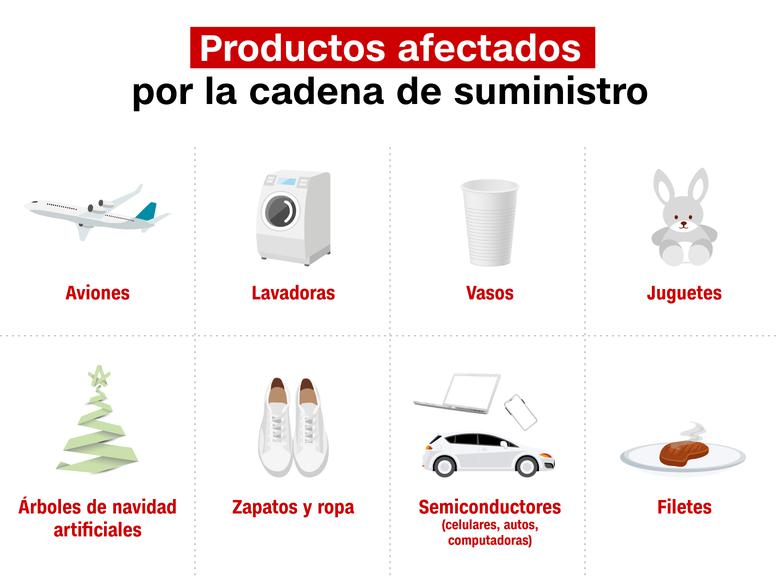What are the main products affected by the crisis in the supply chain?
(CNN Spanish) -- From semiconductors to fuels, through toys, clothing and food, a long list of everyday products are being affected by the crisis in the supply chain that hits the global economy, generating shortages and increased demand. prices.
This crisis in the supply chain dates back to the beginning of the coronavirus pandemic in 2020, when the harsh restrictions to curb contagion led to a sharp drop in demand and economic activity, putting the brakes on production. Major port and factory closures were also recorded due to outbreaks of cases.
According to World Bank estimates, the global economy contracted by 3.59% during 2020 and as a consequence of these restrictions. The IMF projects a rebound of 6% for 2021, in a context of slowing growth.
But as activity resumes and demand for goods picks up, global production is being affected by border controls and mobility restrictions - which make it difficult to get sailors and drivers to transport goods. , the lack of investments during 2020, the increase in transportation costs due to the price of fuel and other factors.
advertisingHere are some of the products most affected by this crisis in the supply chain.
Food and drinks
In the United States there have been abrupt price increases in soft drinks, tortillas -due to the lack of corn- and meat sold in stores.
In the case of beverages, the shortage of glass bottles from Asia is affecting the production of soft drinks, supermarket manager Erica Muñoz, located in Atlanta, told CNN. She also indicated that meat has had increases of up to 30%.
Coffee price increases are also expected due to bad weather in Brazil, protests in Colombia and high transportation costs.
Manufactured products
The cost of goods leaving factories in China, the world's leading manufacturer, is rising at the highest rate on record, affecting consumption across the globe.
The producer price index - which measures the cost of goods sold to businesses - soared 10.7% in September from a year ago, according to government data released Thursday. This is the fastest increase since 1996, when the government began publishing this data, according to data from Eikon Refinitiv.
Companies around the world that source goods from China are already struggling with port congestion, rising freight rates and delays. Rising prices and reduced production could spell further trouble for global supply chains, which are already under enormous pressure.

Of cars, clothes and toys
In the case of automobiles, Goldman Sachs warned in August of falling auto inventories, which remain below pre-coronavirus levels.
Meanwhile, the sportswear company Nike could run out of supplies of sports shoes from Vietnam, where the increase in infections has forced the temporary closure of factories, according to the consulting firm S&P Global.
On the other hand, container shortages, limited cargo space on ocean-going vessels, and rising costs have forced toymakers to make numerous concessions about which goods make the most economic sense.
In this way, toy sellers in the United States have decided to prioritize small and soft toys for this Christmas season, since more of them fit in the containers.
High transportation costs and container shortages are also creating problems in the supply chain.
fuels
Power demand is soaring around the world as the global economy reopens following restrictions imposed in 2020 to deal with the coronavirus. But the supply does not keep pace.
China is having trouble meeting coal demand due to pandemic-induced problems at its main supplier, Australia, but also due to heavy rains and a series of deadly accidents at its plants. Also, recent government policies to reduce carbon emissions have had an impact on highly polluting coal production.
The price of thermal coal, which is mainly used to generate power, has continued to rise. Futures jumped 11% on the Zhengzhou Commodity Exchange on Tuesday to hit a new record high of nearly 1,508 yuan ($234) per metric ton. This rise came after an 8% rise on Monday.
In Europe the cost of wholesale natural gas has skyrocketed to record highs in the UK, France, Spain, Germany and Italy. Home and business bills have already skyrocketed, and could rise even higher as the cold weather approaches and more fuel is needed for electricity generation and heating systems.
Meanwhile, high oil prices in the United States are once again above US$ 80 per barrel -they have not reached these values since 2014-, a blessing for the energy industry, hit during the pandemic, but bad news for the recovery. economically as winter approaches.
On Monday the price of diesel fuel reached an all-time high at German gas stations, according to the German Automobile Association (ADAC). A liter now costs an average of 1,555 euros ($1,797, and has just broken the previous record (1,554 euros) set on August 26.
While in the United Kingdom, the lack of drivers to take fuel from ports to service stations is causing a shortage of this product and long lines at gas stations.
semiconductors
Semiconductors, or chips, have been in short supply throughout 2021 and the shortage is expected to last until mid-2023, according to Intel.
These shortages affect numerous industries that use chips, such as the automotive industry and manufacturers of electronic products, including smartphones, making final products more expensive.
Among the reasons to explain this situation is the coronavirus pandemic, which plunged the world economy into recession last year. In that context, automakers reduced chip orders, while technology companies, whose products were favored by confinement measures, hoarded as many as they could.
Other circumstances, such as US government sanctions on Chinese tech companies and extreme weather conditions, have also contributed to supply shortages.
In January 2021 automakers such as Ford, Nissan, Volkswagen and Toyota had to temporarily suspend production at some of their plants due to a lack of chips - an average car requires between 50 and 150 semiconductors.
In October it was reported that new car sales had slumped in the past three months in the United States despite strong demand, as computer chip shortages and other supply chain problems led to walkouts at auto factories. and hampered the supply of vehicles.
supply chain



